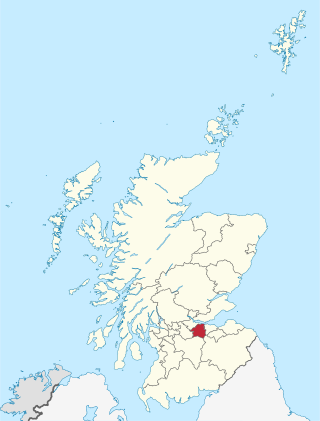
West Lothian is one of the 32 council areas of Scotland, and was one of its historic counties. The county was called Linlithgowshire until 1925. The historic county was bounded geographically by the Avon to the west and the Almond to the east. The modern council area occupies a larger area than the historic county. It was reshaped following local government reforms in 1975: some areas in the west were transferred to Falkirk; some areas in the east were transferred to Edinburgh; and some areas that had formerly been part of Midlothian were added to West Lothian.

Falkirk is a town in the Central Lowlands of Scotland, historically within the county of Stirlingshire. It lies in the Forth Valley, 23+1⁄2 miles northwest of Edinburgh and 20+1⁄2 miles (33 km) northeast of Glasgow.
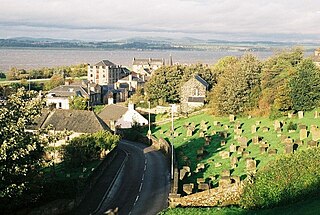
Borrowstounness is a town and former burgh and seaport on the south bank of the Firth of Forth in the Central Lowlands of Scotland. Historically part of the county of West Lothian, it is a place within the Falkirk council area, 17 miles northwest of Edinburgh and 6+3⁄4 miles east of Falkirk. At the 2011 United Kingdom census, the population of the Bo'ness locality was 15,100.
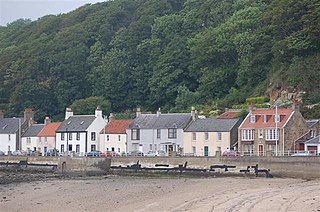
Limekilns is a village in Fife, Scotland. It lies on the shore of the Firth of Forth, around 3 miles (5 km) south of Dunfermline.

Airth is a Royal Burgh, village, former trading port and civil parish in Falkirk, Scotland. It is 6 miles north of Falkirk town and sits on the banks of the River Forth. Airth lies on the A905 road between Grangemouth and Stirling and is overlooked by Airth Castle; the village retains two market crosses and a small number of historic houses. At the time of the 2001 census the village had a population of 1,273 residents but this has been revised to 1,660 according to a 2008 estimate.

Denny is a town in the Falkirk council area of Scotland. Historically in Stirlingshire, it is situated 7 miles west of Falkirk, and 6 miles (10 km) northeast of Cumbernauld, adjacent to both the M80 and M876 motorways. At the 2011 census, Denny had a resident population of 8,300.

Cleland is a village near Motherwell and Wishaw in North Lanarkshire, Scotland. As of 2018, it has a population of about 3,000. The village has a strong coal mining heritage, and is a typical example of a working class village in North Lanarkshire and the Glasgow area. Due to its location, despite being at the heart of North Lanarkshire, the village is isolated, geographically and culturally, from surrounding towns such as Motherwell, Shotts and Wishaw.
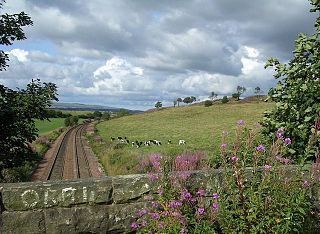
The Cumbernauld Line is a suburban railway line linking Glasgow to Falkirk via Cumbernauld in Scotland. Since May 2014, the newly electrified track between Springburn and Cumbernauld has become an extension of the North Clyde network.
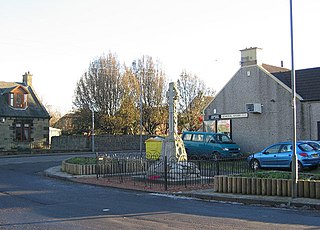
Avonbridge is a small village which lies within the Falkirk council area of Scotland. The village is 4.8 miles (7.7 km) south-southeast of the town of Falkirk. Avonbridge sits just inside the council boundary line between Falkirk and West Lothian councils.
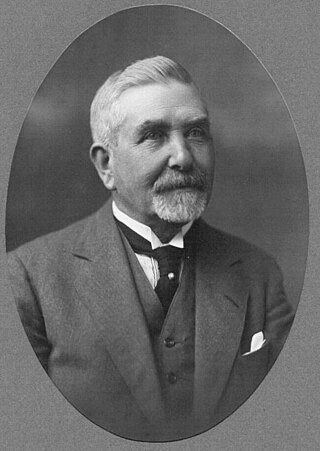
Thomas Wyllie Howie, JP was a Scottish captain of industry.

Callendar House is a mansion set within the grounds of Callendar Park in Falkirk, central Scotland. During the 19th century, it was redesigned and extended in the style of a French Renaissance château fused with elements of Scottish baronial architecture. However, the core of the building is a 14th-century tower house.

Brightons is a village in the east of the Falkirk council area of Scotland. It is 2.7 miles (4.3 km) south-east of Falkirk, 2.2 miles (3.5 km) south of Grangemouth and 4.6 miles (7.4 km) east of Linlithgow. It is surrounded by the villages of Polmont, Wallacestone and Rumford. It is central within the Braes area of Falkirk which makes it “Capital of the Braes”

Westquarter is a village in the Falkirk council area of Scotland. The village is 1 mile (1.6 km) west of Polmont and 1.8 miles (2.9 km) south-east of the town of Falkirk.
Knockentiber is a village in East Ayrshire, Parish of Kilmaurs, Scotland. Knockentiber is two miles west-northwest of Kilmarnock and 1⁄2 mile northeast of Crosshouse. Latitude:55.6193°N Longitude:4.5455°W and grid reference NS397392. The population was 359 in 1991, however the population is much higher following the construction of several housing estates (2007). In the 18th and 19th and mid 20th centuries the locality was a highly industrialised coal mining district. The settlement is on the Carmel Burn, which runs into the River Irvine, around one mile to the south.

Glen Village is a settlement in the Falkirk council area of Scotland, situated at the southern end of Callendar Park, and around 1 mile (1.6 km) south of Falkirk town centre. It adjoins the housing estate of Hallglen, with the two localities counted together in most official statistics.
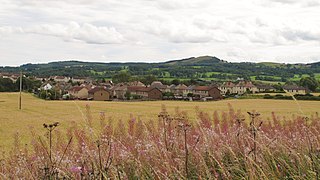
Whitecross is a small village within the Falkirk council area, close to the boundary of West Lothian council in Scotland. It lies 2.0 miles (3.2 km) west-southwest of Linlithgow and 2.5 miles (4.0 km) south-east of Polmont on the west bank of the River Avon. Until the end of World War II it was literally a handful of buildings, but expanded thereafter with a housing estate planned by Stirlingshire County Council in 1945.
The Switchback was a railway line in the East End of Glasgow, Scotland, constructed by the Caledonian Railway (CR). Connecting the lines at Rutherglen on the south side of the city with Robroyston on the north side, this route also served a number of industrial sidings and rail yards.

Bannockburn House is a property of historical significance in the town of Bannockburn. It is a Category A listed building.

Jerviston is a country estate on the north-eastern edge of the Scottish town of Motherwell in North Lanarkshire which is now occupied by Colville Park Country Club.
The Falkirk Braes is a geographical and sociopolitical entity within the Falkirk local authority area in Scotland. The population is approximately 32,000 (2018), about 20% of the total for Falkirk council area.

















